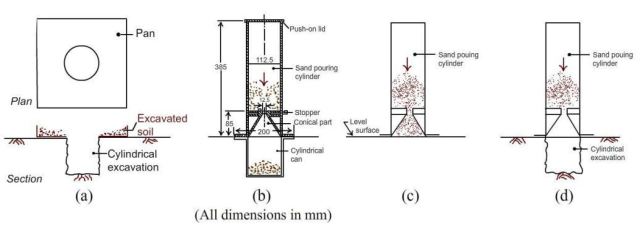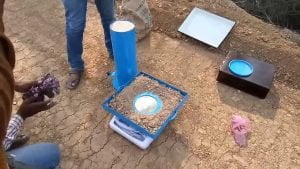Table of Contents
Usually, the soil after compaction in the field has to be checked for the specified dry density. This is usually done by the sand replacement method.
This method is also commonly known as the Sand Cone Method.

The determination of dry density is of utmost importance as it is required for the estimation of the bearing capacity of the soil.
Furthermore, it is also used for assessing the pressure on underlying strata of soil, settlement of the soil as well as the stability of the soil layer.
This method is highly suitable for cohesionless soil.
The general test procedure for determining the dry density of soil by the sand replacement method is relatively simple and easy to conduct.
The test can be carried out using a small or large cylinder. Commonly, it is conducted using a large cylinder.
The sand replacement test is mostly carried out either at the ground level or the formation level.
1. Objective of Sand Replacement Method
✔ The primary objective of the sand replacement method is to determine the dry density of soil.
✔ It is used as a control test to check if the soil has acquired the designated dry density after compaction.
The determined in situ dry density is necessary for the design of pavement and highways as well as for the estimation of the quantity of the base and subgrade course materials.
2. Apparatus Required
1. Sand Cone Apparatus or Sand Pouring Cylinder.
2. Soil excavation and cutting equipment such as scrapers.
3. A plane surface such as a square glass plate with a thickness of 9mm or larger.
4. A metal container for the collection of the excavated soil.
5. A square metal tray about 40 mm deep consisting of a hole of about 100mm in diameter at the center of the tray.
6. Weighing balance with an accuracy of up to 1 gram.
7. A ventilated oven.
3. Materials Required
✔ The sample of sand to be used for the test must be well cleaned and uniform.
✔ It must pass through a 1mm IS sieve and be retained on 600 microns IS sieve.
It must be noted that the sample of sand must be free from any organic matter and other toxic substances.
✔ The sand must be dried in a ventilated oven and left undisturbed for some time so that the water content of the sample can get sufficient time to reach equilibrium along with atmospheric humidity.
4. Procedure
The procedure for the determination of dry density by the sand replacement method involves the following series of steps:
i. Initially, the apparatus is set up as shown in the figure below.
ii. The square tray is then taken and placed on the leveled ground.
iii. A small quantity of soil is then excavated from the hole.
iv. The excavated soil is duly weighed and the water content of the excavated soil is determined.
v. The hole is then filled by the sand of known density from a sand bottle.
vi. Then, the weight of the sand filling the cone of the sand bottle is taken separately.
vii. The dry density is computed as follows:
Weight of sand filling the hole = W 2 – W 3 – W 4
Unit weight of sand = γ
Volume of sand = (W 2 – W 3 – W 4 ) / γ = Volume of hole (V)
Bulk density (γ t ) = W 1 / V
Thus,
Dry Density (γ d ) = γ t / ( 1 + W)
Where,
W 1 = Weight of soil in the hole
W 2 = Weight of the sand bottle before pouring
W 3 = Weight of sand bottle after pouring
W 4 = Weight of sand filling conical funnel
W = Water Content
5. Advantages of Sand Replacement Method
1. The results obtained from the sand replacement method are more appropriate than those obtained from the core cutter method.
2. The test procedure is relatively simple and easy to conduct.
3. Highly skilled manpower and advanced equipment are not required.
6. Limitations of Sand Replacement Method
1. Sand replacement method is not suitable for granular soils with a very high void ratio. This is because the large voids allow the sand to pour down through these voids.
2. Sand replacement method is also not desirable for plastic or highly organic soils.
| Read Also: Core Cutter Method |


